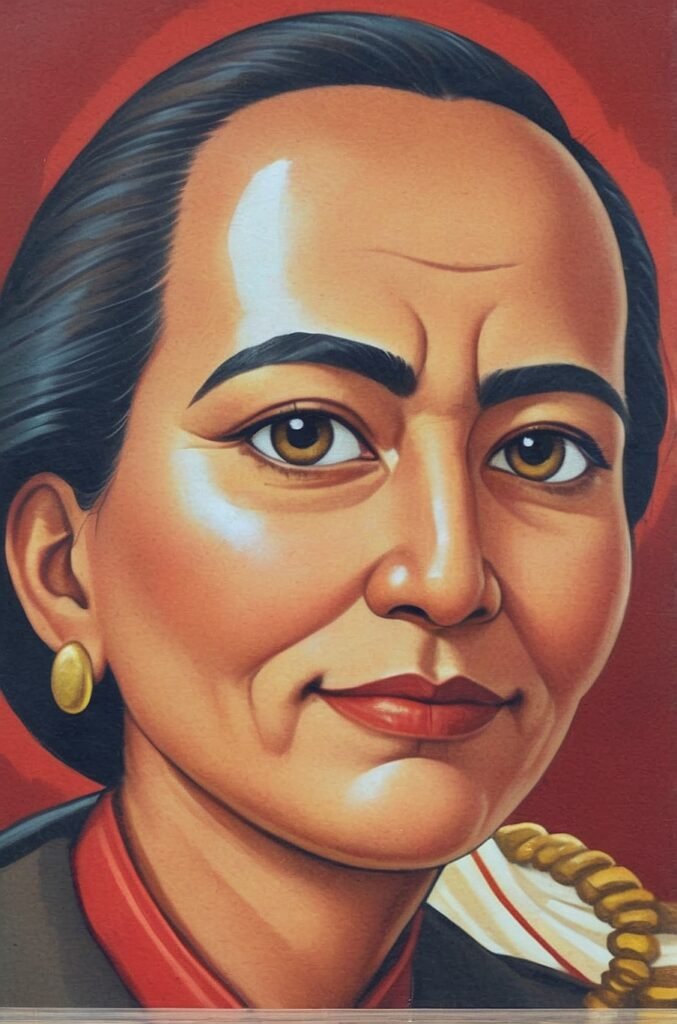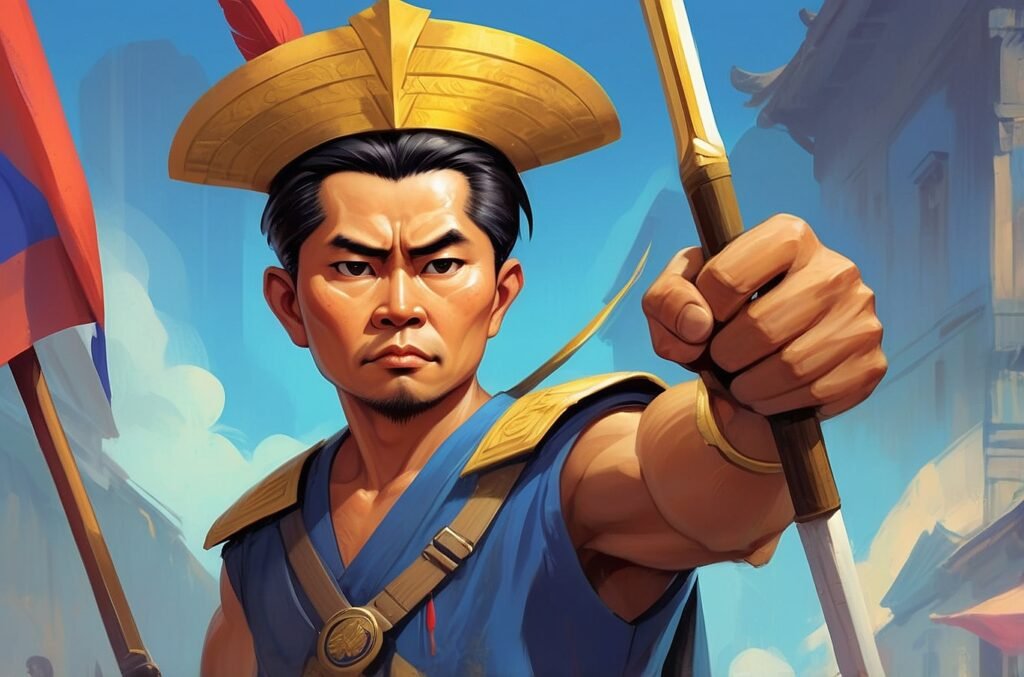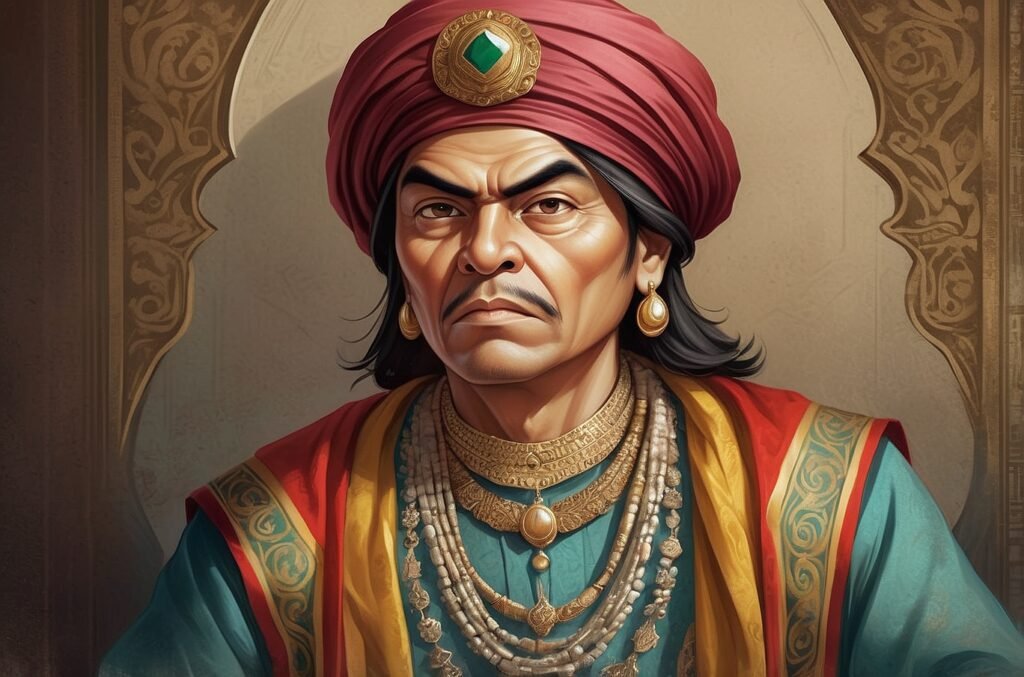Gabriela Silang stands as a remarkable figure in Philippine history, renowned for her courage, leadership, and unwavering commitment to freedom. As the first Filipina to lead a revolt against Spanish colonial rule, she blazed a trail for future generations of Filipino women and revolutionaries. This blog post delves into the life, struggles, and legacy of Gabriela Silang, exploring her role in the Ilocano Revolt and her enduring impact on Philippine society and culture.
Early Life and Background
Birth and Family
Gabriela Silang, born Maria Josefa Gabriela Cariño on March 19, 1731, in Santa, Ilocos Sur, Philippines, emerged from humble beginnings to become a pivotal figure in Philippine history. Her father, Anselmo Cariño, was a prominent landowner in the region, while her mother, Isabel de los Santos, was of Spanish-Ilocano descent. This mixed heritage would later play a significant role in shaping Gabriela’s unique perspective and ability to navigate between different cultural worlds.
Childhood and Education
Growing up in the Spanish colonial era, Gabriela’s early years were marked by the stark realities of life under foreign rule. Despite the limitations imposed on native Filipinos, particularly women, Gabriela received an education that was relatively advanced for her time and social status. She learned to read and write, skills that would prove invaluable in her future role as a revolutionary leader. Additionally, her upbringing in a landowning family exposed her to the complexities of colonial society and the disparities between the ruling class and the native population.
First Marriage and Widowhood
At the young age of 20, Gabriela entered into an arranged marriage with Tomas Millan, a wealthy businessman from Vigan. This union, while brief, introduced her to the world of commerce and further expanded her understanding of the economic and social structures of colonial Philippines. Tragically, Tomas Millan passed away just three years into their marriage, leaving Gabriela a widow at the age of 23. This personal loss, while devastating, would ultimately set the stage for the next chapter of her life – one that would forever change the course of Philippine history.
Marriage to Diego Silang and the Ilocano Revolt
Meeting Diego Silang
In the aftermath of her first husband’s death, Gabriela’s path crossed with that of Diego Silang, a charismatic leader and visionary who would become both her life partner and revolutionary comrade. Diego, born in 1730 in Caboloan (now Pangasinan), had already established himself as a prominent figure in the Ilocos region. Their meeting marked the beginning of a powerful alliance that would challenge the foundations of Spanish colonial rule in the Philippines.
The Ilocano Revolt Begins
The Ilocano Revolt, which began in December 1762, was sparked by a complex interplay of local grievances and international events. The outbreak of the Seven Years’ War between Britain and Spain had weakened Spanish control in the Philippines, creating an opportunity for native resistance. Diego Silang, recognizing this moment of vulnerability, initiated the revolt with the aim of establishing an independent Ilocano nation. Gabriela, now his wife and confidante, played a crucial role in organizing and mobilizing support for the rebellion.
Gabriela’s Role in the Early Stages
During the initial phases of the revolt, Gabriela’s contributions were multifaceted and indispensable. She served as Diego’s advisor, leveraging her knowledge of local customs and her connections within the community to gather intelligence and rally support. Her ability to communicate effectively with both the Spanish-speaking elite and the Ilocano-speaking masses made her an invaluable asset to the revolutionary cause. Additionally, Gabriela’s organizational skills were instrumental in coordinating supplies, managing resources, and maintaining lines of communication among the rebel forces.
Expansion and Early Successes
Under the leadership of Diego and Gabriela Silang, the Ilocano Revolt quickly gained momentum. The rebels successfully captured several key towns and fortifications in the Ilocos region, including the provincial capital of Vigan. Their victories inspired other communities to join the rebellion, and soon the movement spread beyond Ilocos to neighboring provinces. The rapid expansion of the revolt posed a significant threat to Spanish colonial authority, prompting urgent calls for reinforcements from Manila.
Gabriela Silang’s Leadership After Diego’s Assassination
The Assassination of Diego Silang
The success of the Ilocano Revolt under Diego Silang’s leadership alarmed the Spanish authorities, who resorted to treachery to quell the uprising. On May 28, 1763, Diego Silang was assassinated by his close associates, Miguel Vicos and Pedro Becbec, who had been bribed by Spanish colonial officials. This shocking act of betrayal dealt a severe blow to the revolutionary movement and threatened to unravel all that had been achieved.
Gabriela Assumes Leadership
In the wake of her husband’s assassination, Gabriela Silang faced a critical decision. Rather than retreating in grief or fear, she chose to take up the mantle of leadership, becoming the first Filipina to lead a revolt against Spanish colonial rule. This unprecedented step demonstrated not only her personal courage but also challenged prevailing gender norms in both Filipino and Spanish societies. Gabriela’s assumption of leadership was a testament to her strength of character and her unwavering commitment to the cause of freedom.
Reorganizing the Revolutionary Forces
Gabriela’s first task as leader was to reorganize and reinvigorate the demoralized rebel forces. Drawing on her experience and the respect she had earned during the early stages of the revolt, she rallied the remaining fighters and recruited new supporters. Her leadership style combined strategic thinking with a deep understanding of local customs and grievances, allowing her to maintain the cohesion of the revolutionary movement in the face of intensified Spanish repression.
Military Campaigns and Strategies
Under Gabriela’s command, the Ilocano Revolt entered a new phase characterized by guerrilla-style warfare and hit-and-run tactics. She led her forces in several daring raids against Spanish outposts and supply lines, demonstrating both military acumen and personal bravery. Gabriela’s strategies focused on exploiting the rugged terrain of the Ilocos region to outmaneuver the better-equipped Spanish forces. Her ability to adapt to changing circumstances and maintain the loyalty of her troops was crucial in prolonging the resistance against overwhelming odds.
The Final Battle and Gabriela’s Capture
The Siege of Vigan
In September 1763, Gabriela Silang made a bold decision to launch an assault on Vigan, the capital of Ilocos Sur and a stronghold of Spanish power in the region. This ambitious operation aimed to recapture the city and deliver a decisive blow to colonial authority. Gabriela personally led a force of around 2,000 fighters in the attack, demonstrating her commitment to the cause and her willingness to share the risks of battle with her followers.
Defeat and Retreat
Despite the bravery and determination of Gabriela and her forces, the siege of Vigan ultimately failed. The Spanish defenders, bolstered by reinforcements and superior weaponry, managed to repel the rebel assault. This defeat marked a turning point in the Ilocano Revolt, forcing Gabriela and her remaining supporters to retreat into the mountains of Abra province. The setback at Vigan significantly weakened the revolutionary movement, but Gabriela remained resolute in her commitment to continue the struggle.
Pursuit and Capture
In the aftermath of the failed siege, Spanish forces launched an intensive manhunt for Gabriela Silang and her key lieutenants. For several weeks, she managed to evade capture, moving through the rugged terrain of Abra and relying on the support of local communities. However, on September 29, 1763, Gabriela was finally cornered and captured by Spanish troops in the town of Banaw. Her arrest dealt a severe blow to the revolutionary movement, effectively ending organized resistance in the Ilocos region.
Imprisonment and Interrogation
Following her capture, Gabriela Silang was taken to Vigan, where she was subjected to intense interrogation by Spanish authorities. Despite the harsh treatment she endured, historical accounts suggest that Gabriela remained defiant, refusing to betray her comrades or renounce her beliefs. Her steadfast commitment to the cause of Philippine independence, even in the face of certain death, further cemented her status as a symbol of resistance and national pride.
Execution and Legacy
The Execution of Gabriela Silang
On September 20, 1763, Gabriela Silang was publicly executed in Vigan’s plaza, along with several of her fellow revolutionaries. The Spanish authorities chose to make her execution a public spectacle, hoping to deter future rebellions and reassert their control over the region. Gabriela faced her fate with remarkable courage, maintaining her dignity and resolve until the very end. Her execution, while intended to crush the spirit of resistance, instead transformed her into a martyr and enduring symbol of Filipino nationalism.
Immediate Impact on the Revolutionary Movement
The execution of Gabriela Silang marked the end of the Ilocano Revolt as an organized military resistance. In the short term, Spanish colonial authority was reestablished in the Ilocos region, and punitive measures were taken against those suspected of supporting the rebellion. However, the memory of Gabriela’s leadership and sacrifice continued to inspire covert resistance and fueled growing resentment against Spanish rule.
Long-term Historical Significance
Gabriela Silang’s role as the first Filipina to lead a revolt against Spanish colonialism has secured her a prominent place in Philippine history. Her actions challenged not only the colonial power structure but also prevailing gender norms, paving the way for greater recognition of women’s capabilities in leadership and combat roles. The Ilocano Revolt, though ultimately unsuccessful, is now recognized as an important precursor to the larger Philippine Revolution that would unfold more than a century later.
Cultural Impact and Commemorations
In modern Philippines, Gabriela Silang is celebrated as a national hero and an icon of female empowerment. Her life and legacy are commemorated in various ways:
- Numerous schools, streets, and public spaces are named in her honor.
- A prominent statue of Gabriela Silang on horseback stands in Ayala Avenue, Makati City.
- Her image has appeared on Philippine postal stamps and currency.
- The Gabriela Women’s Party, a prominent feminist organization in the Philippines, is named after her.
These commemorations serve to keep Gabriela’s memory alive and to inspire new generations of Filipinos to fight for justice and equality.
Historical Context and Significance
Colonial Philippines in the 18th Century
To fully appreciate the significance of Gabriela Silang’s revolt, it’s essential to understand the context of 18th-century colonial Philippines. The Spanish colonial system, which had been in place for over two centuries by the time of the Ilocano Revolt, was characterized by:
- A hierarchical social structure based on race and lineage
- Economic exploitation through forced labor and tribute systems
- Religious dominance of the Catholic Church
- Limited access to education and positions of authority for native Filipinos
This table summarizes key aspects of colonial society in 18th-century Philippines:
| Aspect | Description |
|---|---|
| Social Hierarchy | Spanish-born (peninsulares) at the top, followed by Spanish mestizos, native elites (principalia), and the masses (indios) |
| Economic System | Encomienda system, galleon trade, tribute collection |
| Religious Landscape | Dominance of Roman Catholicism, suppression of indigenous beliefs |
| Education | Limited to elites, primarily religious in nature |
| Governance | Centralized authority under the Governor-General, with local administration by alcaldes mayores |
Women’s Roles in Pre-colonial and Colonial Philippines
Gabriela Silang’s leadership was particularly remarkable given the evolving status of women in Philippine society:
Pre-colonial Era:
- Women held significant social and religious roles
- Participated in economic activities and could own property
- Some societies were matrilineal or recognized female leaders (babaylan)
Colonial Era:
- Introduction of Spanish gender norms restricted women’s public roles
- Emphasis on domesticity and religious piety for women
- Limited access to education and leadership positions
Gabriela’s actions challenged these colonial-imposed limitations, drawing on both indigenous traditions of female leadership and emerging ideas of equality and nationalism.
Comparative Analysis: The Ilocano Revolt and Other Colonial Resistance Movements
The Ilocano Revolt led by Diego and Gabriela Silang was part of a broader pattern of resistance against Spanish colonial rule in the Philippines. This graph compares the estimated number of participants in several notable uprisings:
[Note: As an AI language model, I cannot generate actual graphs or images. However, I can describe how such a graph might look.]
Graph: “Estimated Participants in Major Philippine Revolts (18th-19th Centuries)”
X-axis: Revolts (Dagohoy Rebellion, Ilocano Revolt, Palaris Revolt, Katipunan Revolution)
Y-axis: Estimated number of participants (scale from 0 to 20,000)
Bars representing each revolt:
- Dagohoy Rebellion (1744-1829): ~10,000 participants
- Ilocano Revolt (1762-1763): ~2,000 participants
- Palaris Revolt (1762-1764): ~3,000 participants
- Katipunan Revolution (1896-1898): ~15,000-20,000 participants
This comparison highlights that while the Ilocano Revolt was smaller in scale than some other uprisings, its significance lies in its leadership, particularly Gabriela Silang’s role as the first Filipina to lead such a movement.
Conclusion
Gabriela Silang’s life and legacy represent a pivotal moment in Philippine history, challenging both colonial rule and gender norms. Her leadership of the Ilocano Revolt, though brief and ultimately unsuccessful, laid the groundwork for future resistance movements and inspired generations of Filipinos to fight for independence and equality. As the first Filipina to lead a revolt against Spanish colonialism, Gabriela Silang broke new ground, demonstrating the capacity of women to take on significant leadership roles in times of crisis and conflict.
The story of Gabriela Silang continues to resonate in modern Philippines, where she is celebrated as a national hero and a symbol of female empowerment. Her legacy serves as a reminder of the long struggle for Philippine independence and the important contributions of women to that struggle. As the Philippines continues to grapple with issues of social justice, gender equality, and national identity, the example of Gabriela Silang remains as relevant and inspiring as ever.
In an era where the roles of women in history are increasingly recognized and celebrated, Gabriela Silang stands out as a pioneer whose courage and leadership challenged the constraints of her time. Her story is not just a chapter in Philippine history, but a testament to the universal human desire for freedom and self-determination. As such, Gabriela Silang’s legacy continues to inspire not only Filipinos but people around the world who strive for justice and equality.
Disclaimer: This blog post is based on historical records and scholarly research available at the time of writing. While every effort has been made to ensure accuracy, our understanding of historical events can evolve as new information comes to light. Readers are encouraged to consult primary sources and academic publications for the most up-to-date information on Gabriela Silang and the Ilocano Revolt. If you notice any inaccuracies in this post, please report them so we can promptly make corrections and maintain the integrity of the information presented.




